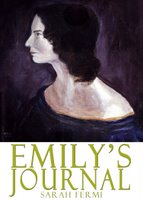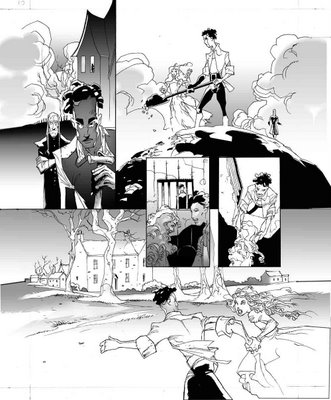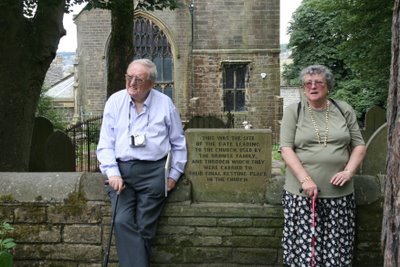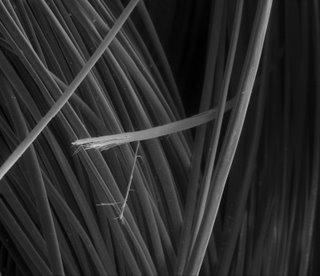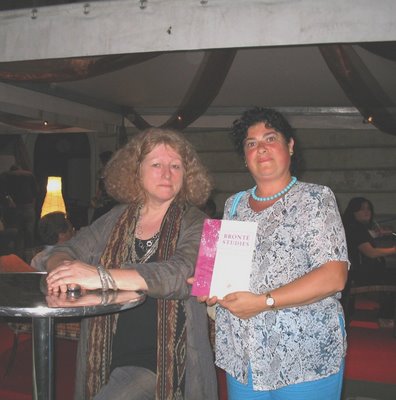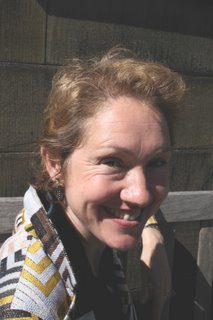Michele Carter writes:
As a child, I asked my Irish father if he believed in ghosts. He said, ‘No, I don’t believe in them, but they do exist.’ This philosophy came in handy at The Brontë Society Conference last September when Ann Dinsdale, Librarian at the Parsonage, took a few of us on a guided walk around historic Haworth. After a visit to the churchyard, we wandered over to number forty-three Sun Street where the Brontës' servant Tabby Aykroyd had died in 1855.
The owner came out and told us that he and his wife had just moved into the premises a few months ago and that, immediately, strange goings-on had begun.
Our group gathered closer.
‘I was coming back from a bit of shopping,’ he explained. ‘When I looked through the door’s window, I saw a little grey-haired lady walk across the hall through to the kitchen and just disappear. I went in and looked around for her, but she was nowhere about. She’d just vanished.’
A communal gasp.
‘And we keep hearing someone knocking, but when we open the door nobody’s there.’
A gasp and a nod. ‘Tabby.’
With ghosts fresh in our minds, we ventured over to Old Fold Hall on Fern Street. This house dates back to the seventeenth century and has recently been restored. The owner approached our group and invited us in to see the new décor.
‘This might sound odd,’ she began, ‘but there’s been some strange goings-on around here since we opened up the fireplace. Right here I saw several small, white shapes. Fluffy shapes really. But I couldn’t tell what they were. I went upstairs and at the same spot, by the fireplace, I saw them again. But never anywhere else in the house.’
We waited for her to continue, not believing in ghosts ourselves but knowing they do exist.
‘It wasn’t until I was in Clapham looking at livestock that I saw the same small, white shapes. They were sheep - miniature sheep. You see, there was sheep breeding here before the mills. Maybe they bred small sheep that could withstand the harsher conditions. And maybe they slept around the fireplace.’
We nodded in unison.
‘With these old houses,’ she continued, ‘it’s no surprise to hear things going boomp in the night. But we also smell damp sackcloth. They kept the wool in bags of sackcloth back then. The smell never lingers. More like onions cooking or coffee and then it’s gone. The gasman smelled it, and he said it’s not gas, it’s sackcloth.’
We casually sniffed.
‘But that’s not all.’ She stepped toward the door. ‘The other day, I was standing right here and just happened to look out the window and saw a little grey-haired lady coming to my door. She was coming right to it, but when I opened it, she was gone.’
‘Tabby.’
‘What?’
We explained about Tabby and the knocking over on Sun Street. ‘Lately, someone’s been wiggling our latch, but when we open the door no one’s there.’
‘Tabby.’
Grey ghosts, tiny sheep, spirit sackcloth. I silently wondered if the Brontës ever heard wee ghosties going boomp in the night.
Ann Dinsdale and some of her intrepid group can be seen below:

As a child, I asked my Irish father if he believed in ghosts. He said, ‘No, I don’t believe in them, but they do exist.’ This philosophy came in handy at The Brontë Society Conference last September when Ann Dinsdale, Librarian at the Parsonage, took a few of us on a guided walk around historic Haworth. After a visit to the churchyard, we wandered over to number forty-three Sun Street where the Brontës' servant Tabby Aykroyd had died in 1855.
The owner came out and told us that he and his wife had just moved into the premises a few months ago and that, immediately, strange goings-on had begun.
Our group gathered closer.
‘I was coming back from a bit of shopping,’ he explained. ‘When I looked through the door’s window, I saw a little grey-haired lady walk across the hall through to the kitchen and just disappear. I went in and looked around for her, but she was nowhere about. She’d just vanished.’
A communal gasp.
‘And we keep hearing someone knocking, but when we open the door nobody’s there.’
A gasp and a nod. ‘Tabby.’
With ghosts fresh in our minds, we ventured over to Old Fold Hall on Fern Street. This house dates back to the seventeenth century and has recently been restored. The owner approached our group and invited us in to see the new décor.
‘This might sound odd,’ she began, ‘but there’s been some strange goings-on around here since we opened up the fireplace. Right here I saw several small, white shapes. Fluffy shapes really. But I couldn’t tell what they were. I went upstairs and at the same spot, by the fireplace, I saw them again. But never anywhere else in the house.’
We waited for her to continue, not believing in ghosts ourselves but knowing they do exist.
‘It wasn’t until I was in Clapham looking at livestock that I saw the same small, white shapes. They were sheep - miniature sheep. You see, there was sheep breeding here before the mills. Maybe they bred small sheep that could withstand the harsher conditions. And maybe they slept around the fireplace.’
We nodded in unison.
‘With these old houses,’ she continued, ‘it’s no surprise to hear things going boomp in the night. But we also smell damp sackcloth. They kept the wool in bags of sackcloth back then. The smell never lingers. More like onions cooking or coffee and then it’s gone. The gasman smelled it, and he said it’s not gas, it’s sackcloth.’
We casually sniffed.
‘But that’s not all.’ She stepped toward the door. ‘The other day, I was standing right here and just happened to look out the window and saw a little grey-haired lady coming to my door. She was coming right to it, but when I opened it, she was gone.’
‘Tabby.’
‘What?’
We explained about Tabby and the knocking over on Sun Street. ‘Lately, someone’s been wiggling our latch, but when we open the door no one’s there.’
‘Tabby.’
Grey ghosts, tiny sheep, spirit sackcloth. I silently wondered if the Brontës ever heard wee ghosties going boomp in the night.
Ann Dinsdale and some of her intrepid group can be seen below:



